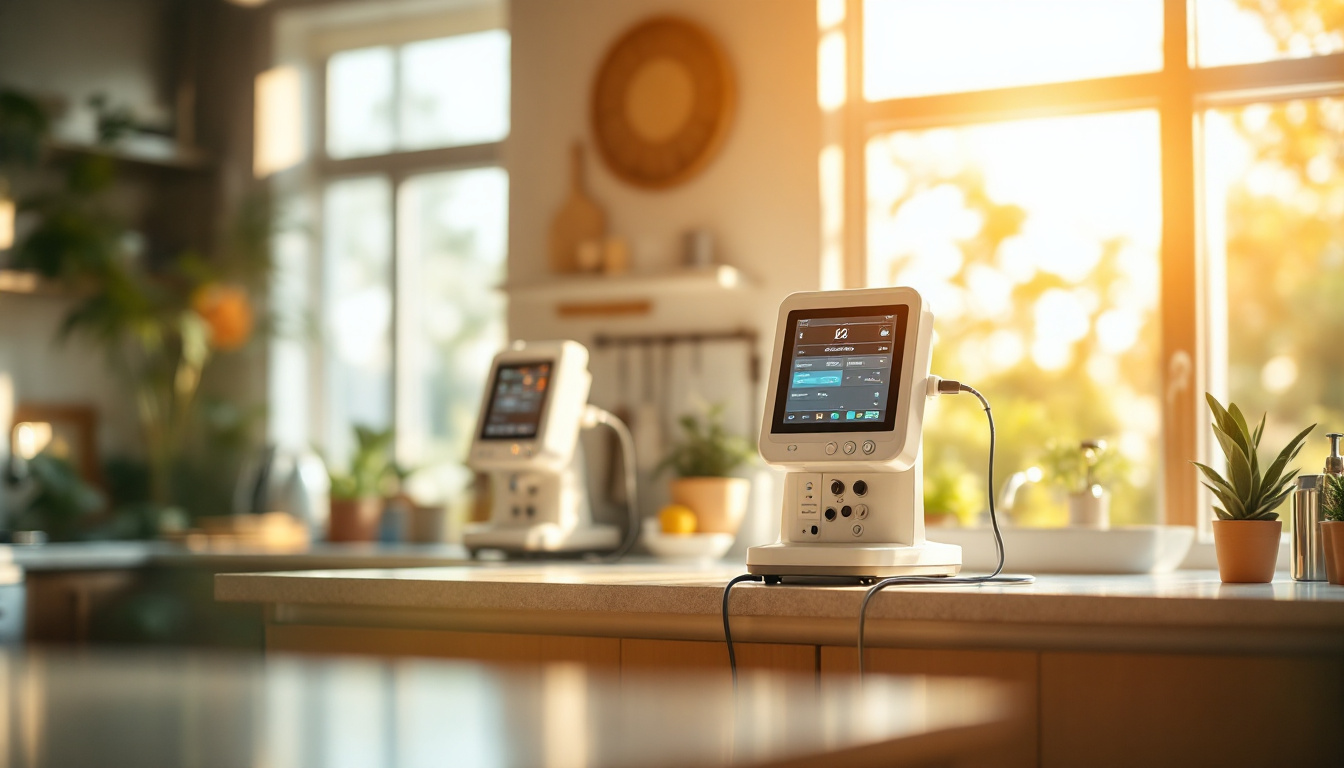Advancements in TPN Formulations and Technology

A Revolutionary Phase in Nutritional Therapy
The field of Total Parenteral Nutrition (TPN) has seen transformative advancements in recent years. From state-of-the-art formulations to innovative technological integrations, TPN continues to evolve, offering enhanced safety and efficacy for patients with complex nutritional needs. This article delves into the historical context, recent innovations, and future directions of TPN technology, focusing on solutions that improve patient outcomes across various sectors of the healthcare industry.
Understanding TPN Technology

What is TPN technology?
Total Parenteral Nutrition (TPN) technology refers to sophisticated methods and medical practices designed to deliver complete nutrition intravenously to patients who cannot consume food orally or enterally. This involves a combination of essential nutrients tailored to individual patient needs, administered through advanced delivery systems to ensure safety and efficacy.
Overview of Total Parenteral Nutrition
TPN consists of a mixture of crucial macronutrients, including dextrose, amino acids, and lipid emulsions, alongside vitamins and minerals. These components are crucial for providing the caloric and nutritional balance necessary for patients who rely on intravenous nutrition, particularly in cases of impaired gastrointestinal function.
Importance of TPN in medical care
TPN plays a vital role in the medical care of approximately 34,000 patients annually in the U.S. It serves as a lifeline for those unable to receive adequate nutrition through traditional means, such as oral or enteral feeding.
Advancements in TPN technology have significantly enhanced patient safety, reduced the risk of complications, and improved overall clinical outcomes. With innovations such as all-in-one (AIO) admixtures, healthcare providers can ensure more efficient and safer nutrition delivery, ultimately enhancing the quality of life for patients requiring this form of support.
Formulating TPN: A Closer Look at Solutions

What are the different types of TPN solutions and their formulations?
Total Parenteral Nutrition (TPN) solutions provide a comprehensive source of nutrients delivered intravenously, crucial for patients unable to obtain nutrition through oral or enteral routes. Each TPN solution is strategically formulated, incorporating the following components:
| Component | Role | Examples |
|---|---|---|
| Lipid Emulsions | Provide essential fatty acids and energy | Soybean oil, Fish oil, Olive oil |
| Dextrose | Primary carbohydrate source | Dextrose monohydrate |
| Amino Acids | Essential for tissue repair and growth | Various pharmaceutical formulations |
| Vitamins | Micronutrients for overall health | B-complex, Vitamins A, C, E |
| Electrolytes | Maintain fluid balance and metabolic processes | Potassium, Sodium, Calcium |
| Minerals | Support various physiological functions | Zinc, Selenium |
| Trace Elements | Vital for enzymatic and hormonal functions | Copper, Chromium |
Adaptation of formulations to patient needs
Each TPN formulation is tailored specifically to meet the nutritional requirements of the patient, considering factors such as age, gender, and underlying health conditions. Personalized adjustments are made, ensuring that the macronutrient composition aligns with individual metabolic needs. This adaptation is essential for optimizing patient outcomes and minimizing potential complications.
FDA regulation of TPN
TPN formulations are strictly regulated by the FDA to ensure patient safety and efficacy. Ongoing assessments and approvals focus on the composition of these nutrient solutions, ensuring they meet rigorous standards. This regulatory oversight helps mitigate risks associated with the administration of TPN, addressing concerns like nutrient deficiencies and adverse liver-related effects.
By combining these innovations and regulatory measures, TPN has become a vital therapeutic tool for managing malnourishment in patients with gastrointestinal dysfunctions.
Why TPN Requires Gradual Discontinuation

Why is TPN discontinued gradually?
TPN (Total Parenteral Nutrition) requires a gradual discontinuation due to its historical practices involving substantial glucose content in the solutions. Abruptly stopping TPN can lead to hypoglycemia because the body’s insulin production could surpass the diminished glucose intake.
Significance of controlled tapering
Controlled tapering allows the body to adjust to changes in glucose levels without overwhelming the metabolic system. This method minimizes risks and ensures blood sugar levels stabilize appropriately.
Historical practices in TPN administration
Historically, health care professionals were aware of complications stemming from rapid changes in nutrition, leading to the development of these tapering protocols to safeguard against potential adverse events.
Concerns related to glucose and insulin
The presence of high glucose in TPN solutions necessitates careful management during discontinuation. Patients reliant on insulin therapy must also consider that sudden halts in TPN may result in imbalanced glucose levels, making managed tapering essential for safety.
Diving Into Common Risks of TPN

What are the most common complications of TPN?
Total parenteral nutrition (TPN) has been a transformative therapy for patients with gastrointestinal failure; however, it is not without risk. The most prevalent complications include:
- Metabolic Abnormalities: Many patients experience metabolic disturbances such as hyperglycemia, refeeding syndrome, and dyslipidemia. Continuous monitoring is essential to manage these conditions effectively.
- Infection Risks from Catheter Use: The use of central venous catheters increases the risk of bloodstream infections, with approximately 10-20% of TPN patients facing adverse events related to human error in preparation and administration. Innovations in catheter technology aim to reduce these risks.
- Long-term TPN Side Effects: Extended use of TPN can lead to liver complications, notably PN-associated liver disease (PNALD). There is ongoing research into developing lipid emulsions that could mitigate these effects, particularly in vulnerable populations such as neonates.
In summary, these risks underscore the importance of careful monitoring and adherence to protocols designed to enhance patient safety during TPN therapy, including the implementation of AI and ML to minimize human errors.
Comparing TPN with Clinimix
How does TPN differ from Clinimix?
Total Parenteral Nutrition (TPN) is a meticulously formulated solution tailored to meet the complete nutritional requirements of patients who cannot utilize their gastrointestinal (GI) systems. In contrast, Clinimix is a pre-mixed, ready-to-use option specifically designed for patients needing moderate to high protein intake.
Differences in composition and usage
| Component | TPN | Clinimix |
|---|---|---|
| Composition | Customized mix of lipids, amino acids, dextrose, vitamins, electrolytes, and trace elements | Pre-mixed amino acids and dextrose with limited vitamins and minerals |
| Administration | Administered via central vein for higher caloric needs | Can be administered more flexibly for immediate support |
| Personalization | Highly individualized based on metabolic needs | Less customizable, designed for broad use cases |
Patient suitability
TPN is indicated for patients with severe GI dysfunction who require comprehensive nutritional support over extended periods. In contrast, Clinimix primarily benefits critically ill patients needing rapid nutrition supplementation
Clinical applications
Both TPN and Clinimix play vital roles in patient care but cater to different clinical scenarios. TPN is essential for chronic cases of malnourishment, while Clinimix is often employed in acute settings to manage immediate nutritional deficits efficiently. Each solution highlights advancements in nutritional therapies and the ongoing need for tailored patient care strategies.
Safer TPN Practices: Technological Integrations
Integration of Advanced Technology
The evolution of Total Parenteral Nutrition (TPN) has significantly benefited from technological advancements. Current methods, such as computer physician order entry (CPOE) systems and barcode-assisted medication preparation (BCMP), enhance the safety of TPN administration. These technologies help minimize errors during preparation by allowing pharmacy technicians to verify each component against a digital record, reducing the risk of contamination and ensuring accurate dosages.
Role of AI and Machine Learning
Artificial intelligence (AI) and machine learning (ML) are emerging solutions aimed at enhancing TPN safety. By automating calculations and monitoring infusion rates, they can potentially reduce the incidence of adverse events related to human error by up to 50%. Despite relatively limited integration in current practices, the promise of these technologies could lead to more precise and personalized TPN regimens, ultimately improving patient outcomes.
Reduction of Human Error in TPN
Approximately 10-20% of TPN patients experience complications due to human error, making it crucial to implement systems that prioritize safety. Technologies like EndoTool provide computerized dosing to maintain optimal glycemic control, which is vital for patients receiving TPN. With ongoing research into validation and regulatory approval, the incorporation of AI and ML might revolutionize TPN delivery, enhancing safety and efficacy across clinical settings.
| Technological Advancement | Functionality | Impact on Patient Safety |
|---|---|---|
| CPOE | Eliminates transcription errors | Real-time safeguards for prescribing |
| BCMP | Scans components for accuracy | Significant reduction in preparation errors |
| AI & ML | Automates dosing and monitoring | Potentially cuts adverse events by 50% |
Patient-Centric Advancements in TPN
Personalized Nutrition in TPN
Total Parenteral Nutrition (TPN) has significantly evolved with a focus on personalized nutrition tailored to individual patient needs. This customization is crucial, especially for patients with specific dietary restrictions or underlying health conditions. Nutritional formulas for TPN account for factors like age, gender, and medical history, enhancing care and improving outcomes.
Advancements in Lipid Formulations
Recent innovations in lipid emulsion technology are transforming TPN formulations. Newer lipid products, including those with fish oil or olive oil, have shown advantages over traditional soybean oil emulsions. These advancements not only provide essential fatty acids but also minimize liver complications and improve lipid metabolism. Enhanced formulations are contributing to more stable outcomes for patients, particularly in vulnerable populations such as neonates.
Reduction of Inflammation
One significant trend in TPN development is the reduction of inflammation, particularly during the COVID-19 pandemic. This shift led to a preference for lipid emulsions with lower inflammation profiles, directly impacting patient health outcomes. Innovations aim to mitigate detrimental inflammatory responses associated with traditional emulsions, enhancing overall safety and efficacy in TPN administration.
| Topic | Innovations | Outcomes Achieved |
|---|---|---|
| Personalized Nutrition | Tailored formulas based on individual needs | Improved patient care and outcomes |
| Advancements in Lipids | Use of fish oil and olive oil emulsions | Reduced liver complications |
| Reduction of Inflammation | Low-inflammation lipid choices | Enhanced overall safety and efficacy |
Through these advancements, TPN continues to develop as a critical therapeutic option for patients who cannot access conventional feeding methods.
All-In-One TPN Admixtures: Streamlining Nutrition
Benefits of AIO Systems
All-in-one (AIO) parenteral nutrition systems have revolutionized how nutritional support is administered to patients who cannot take food orally. These systems combine all essential nutrients—lipids, amino acids, and dextrose—into a single, user-friendly admixture. This streamlined approach minimizes the complexity of preparation and enhances patient compliance while simplifying the overall management of parenteral nutrition.
Reduction of Infection Risks
One of the significant advantages of AIO systems is their ability to reduce infection risks compared to traditional TPN methods. By eliminating the need for component manipulation during preparation, AIO systems minimize the opportunities for contamination, which can lead to serious bloodstream infections. Recent studies show that AIO admixtures can significantly lower infection rates, making them a safer choice for patients requiring long-term nutritional support.
Clinical Advantages Over Traditional TPN Methods
Clinically, AIO systems offer better stability and longer shelf life than customized compounded solutions. Their design also supports improved portability, allowing patients to manage their nutrition with ease. This adaptability is essential for individuals receiving home parenteral nutrition (HPN), empowering them to maintain a higher quality of life without frequent hospital visits. In summary, AIO TPN admixtures represent a crucial step forward in enhancing the safety and effectiveness of parenteral nutrition.
Home Parenteral Nutrition: Expanding Access and Quality
Home TPN technology
Home Parenteral Nutrition (HPN) has transformed the way patients receive essential nutrients, allowing them to maintain their health in a familiar setting. Advanced formulations are tailored to meet individual needs, considering various factors such as age, gender, and underlying medical conditions. A clinical team, including physicians and regulated compounding pharmacies, collaborates to create these personalized solutions.
Impact on patient lifestyle
The ability to administer nutrition at home significantly enhances a patient’s quality of life. For approximately 40,000 individuals in the U.S. who rely on HPN, this means more freedom to engage in social activities and participate in everyday experiences without being tied to a hospital or clinic. It empowers patients to maintain a degree of normalcy despite their medical challenges.
Role of portable infusion pumps
Technological advancements have made HPN less cumbersome, particularly through the development of portable infusion pumps. These devices can easily fit into backpacks, allowing patients to manage their nutrition on-the-go. This innovation not only aids in convenience but also fosters independence, enabling individuals to pursue daily activities with minimal disruption while receiving essential intravenous nutrition.
Lipid Emulsions: Improving Safety and Efficacy
Evolution of lipid formulations
The advancement of lipid emulsions has significantly transformed the realm of parenteral nutrition (PN). Traditional soybean oil-based lipid emulsions (SOLE), standard since the 1970s, have been associated with PN-associated liver disease (PNALD), particularly risk-prone populations like neonates. In response, newer formulations were developed to optimize patient outcomes while minimizing adverse effects.
Introduction of new lipid sources
Emerging lipid sources, such as those derived from fish oil and olive oil, have gained traction as alternatives to conventional emulsions. Fish oil, noted for its anti-inflammatory properties, has shown promise in resolving liver complications linked to TPN. Omegaven, a fish oil-based emulsion, was FDA-approved for pediatric use in 2018, marking a significant milestone in improving safety profiles for vulnerable populations.
Impact on liver complications
The shift towards utilizing new-generation lipid emulsions, including formulations containing medium-chain triglycerides, is paving the way for better clinical outcomes. These advancements not only aim to improve the overall efficacy of parenteral nutrition but also work towards reducing the incidence of hepatic complications associated with long-term TPN — a critical factor for those requiring sustained nutritional support.
| Lipid Emulsion Type | Benefits | Risks |
|---|---|---|
| Soybean Oil (SOLE) | Widely available | Associated with PNALD |
| Fish Oil Emulsions (Omegaven) | Mitigates liver complications | Limited availability, mainly pediatric use |
| Olive Oil & MCTs | Potentially better fatty acid profiles | Emerging data required for further assessment |
This ongoing evolution of lipid emulsions highlights the commitment to enhancing patient safety and care efficiency in parenteral nutrition.
Historical Perspectives and Evolution of TPN
Development from the 1960s
Total parenteral nutrition (TPN) emerged as a revolutionary approach to meet the nutritional needs of patients unable to consume food orally or enterally, particularly those with gastrointestinal dysfunction. The inception of TPN can be traced back to the 1960s when Stanley Dudrick and his team devised methods for intravenous feeding. Their pioneering application of TPN in human subjects marked an important milestone, establishing it as a lifesaving therapy for patients needing complete nutritional support.
Milestones in TPN technology
Since its introduction, TPN technology has consistently evolved to address safety and efficacy challenges. Innovations such as the development of lipid emulsions, amino acid solutions, and multichamber bags have revolutionized TPN, minimizing contamination risks and streamlining administration. Recent advancements, including computer physician order entry (CPOE) systems and barcode-assisted medication preparation (BCMP), have significantly decreased medication errors, enhancing patient safety.
Influence on modern practices
Today, TPN is meticulously tailored to suit individual needs, promoting optimal health outcomes. Its formulations have advanced with higher precision, balancing macronutrients and micronutrients specifically adjusted for various medical conditions. These innovations underscore TPN's critical role both in acute care settings and for patients transitioning to home parenteral nutrition, illustrating its evolution from a novel solution to an essential component of modern medical nutrition therapy.
The Role of AI and Machine Learning in TPN

Automation of TPN Preparation
Artificial Intelligence (AI) and Machine Learning (ML) are transforming how Total Parenteral Nutrition (TPN) is prepared and administered. By automating calculations related to nutrient formulations, AI can streamline the preparation process. This technology minimizes the risk of human error during the compounding stage, where precise measurements are crucial for patient safety.
Prevention of Dosage Errors
The integration of AI in TPN aims to significantly reduce the incidence of adverse events associated with dosage errors. Traditional preparation methods have error rates as high as 9%. In contrast, AI-driven systems have demonstrated potential to cut these errors by up to 50%. Technology such as Computerized Physician Order Entry (CPOE) and barcode-assisted medication preparation (BCMP) play a vital role in ensuring that each nutrient component is accurately prepared, thus reinforcing patient safety.
Improvement of Patient Monitoring
Patient monitoring during TPN administration is enhanced through the use of advanced technologies. AI can analyze real-time patient data, making necessary adjustments to nutrient delivery based on ongoing assessments. This level of monitoring is especially important for managing patients who may be at risk of complications, such as those experiencing hyperglycemia. By optimizing the balance of nutrients and exercising continuous oversight, AI aims to improve overall patient outcomes in TPN therapy.
| Aspect | AI/ML Contribution | Impact on TPN |
|---|---|---|
| Automation of Preparation | Streamlined calculations and nutrient formulation | Reduced human error and improved safety |
| Prevention of Dosage Errors | Real-time monitoring and adjustment of nutrient dosages | Lower incidence of complications |
| Patient Monitoring | Continuous assessment of individual patient needs | Enhanced patient outcomes |
The Future of TPN: Challenges and Prospects
Validation and Regulatory Hurdles
The integration of advanced technologies like artificial intelligence (AI) and machine learning (ML) into Total Parenteral Nutrition (TPN) faces significant hurdles. Despite their promise to reduce human error in TPN preparation and administration, the pathways for validation and regulatory approval remain complex. The medical community recognizes the urgency of addressing these issues, as ensuring patient safety in TPN is paramount.
Exploring New Technologies
Innovative developments are ongoing in TPN technology, particularly relating to lipid emulsions and multichamber bag systems. These advances aim to optimize nutrition delivery while minimizing complications, such as infections associated with traditional methods. Moreover, research into automated systems for drug preparation is exploring ways to enhance the accuracy of dosing and improve efficiency in TPN setups.
Patient Safety and Outcome Aspirations
The overall goals for the future of TPN are centered around increasing patient safety and improving clinical outcomes. This includes developing formulas tailored to individual patient metabolic needs and fostering adherence to stringent aseptic techniques to prevent infections. Enhanced monitoring systems will be integral to achieving these objectives, utilizing real-time data to adjust nutrient compositions based on patient responses. Through these ongoing advancements, TPN aims to become more accessible and safer for the thousands of patients relying on this essential therapy each year.
The Path Ahead
Total Parenteral Nutrition is an indispensable component of modern healthcare, offering life-sustaining nutrition to patients in need. The advancements in formulations and technology are not just about bridging gaps but about redefining patient care. As we continue to navigate this rapidly evolving field, embracing technology and personalized medicine will be crucial in enhancing safety, efficacy, and quality of life for TPN patients. The future holds promise, and the journey of innovation must persist to address the unique challenges of intravenous nutrition.
References
- Advances in Medical Nutrition Therapy: Parenteral Nutrition - PMC
- Total Parenteral Nutrition - StatPearls - NCBI Bookshelf
- AI/ML in Total Parenteral Nutrition | IEEE Computer Society
- Home Total Parenteral Nutrition (Home TPN) - Nutrishare
- Shifting the paradigm of long‐term total parenteral nutrition: Lessons ...
- Trends in Parenteral Nutrition - Today's Dietitian Magazine
- (PDF) Technology in Parenteral Nutrition Compounding
- Total Parenteral Nutrition - an overview | ScienceDirect Topics
- Parenteral Nutrition Modeling and Research Advances - IntechOpen



































































































